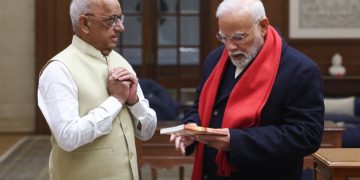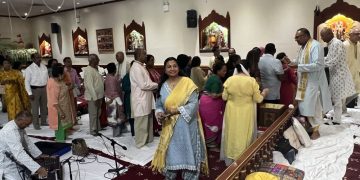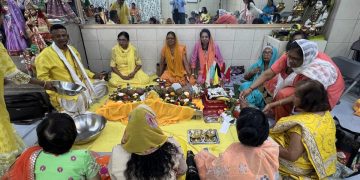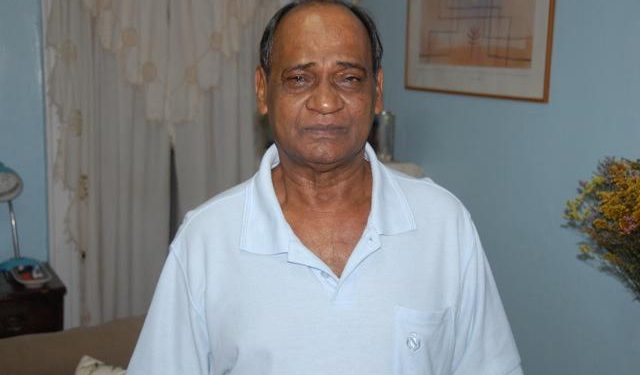It is with sadness I read of the passing of Shri Rooplall Monar of Annandale, East Coast, Guyana. He was one of Guyana’s finest writers, a forerunner or pioneer of using Indian Creolese vernacular in literary writings. His writings were full of emotions, irony, and empathy and grass roots oriented. They carried a rich repertoire of memories using metaphors to capture the lived experience in revelatory terms. Indian culture also ran deep in his writings that started in the 1960s. If one can make a comparison of him with the Naipaul brothers, Monar was grass roots whereas the Naipaul’s were middle class centered.
Monar was also a very good poet, a class of himself, a luminary figure in (Indian) Guyanese literature. His works were recognized by Guyana Literary Prize selectors, and he was honored with AA but not prominent on literary reading lists of University of Guyana and UWI and for CSEC and CAPE. However, he, like every other Indian writers and cultural proponents, did not receive financial support from the state. Indian arts (music and writings) were never considered important or worthy of support by politicians, not even those who depend on Indian votes to win government. As expected, Monar’s great contributions to Guyanese literature continue to be marginalized in his home country as well as in the English Caribbean.
I confess the first time I heard of and read Monar’s writings was when I was a post-graduate student during the 1980s. I was pre-occupied with my studies and anti-dictatorial struggle during the 1970s into the early 1980s with hardly time for the arts like reading literary works although some of that was required in pursuing an undergraduate degree (Bio-Chemistry) in any subject at my university in New York. Indian writers, apart from the Naipaul brothers and KR Narayanan and a few other well-known ones, were not on reading lists of universities. The literature reading list in North America and Europe was Anglicized and Europeanized. After some protests, the works of African American and Spanish writers were included in literature. And after the protests of the Indo-Caribbeans (including myself Vishnu Bisram) and (Bharat) Indians, Indian literary figures (including Indo-Caribbean) became part of the reading lists at universities throughout the USA. A long struggle led to the inclusion of works of Blacks and Hispanics (and recently those from other ethnic groups) in the syllabus of high school and colleges. In recent times, the literary works of Arabic writers and the writings of other ethnic groups, including Guyanese, Trini, Jamaicans, are now part of the reading lists and curriculum in secondary as well as college education. Also, the works of Guyanese and other West Indian literature can be studied as part of standardized tests in English and Literature in New York and multiple states. Unfortunately, Indian writers are still struggling to have their works on the reading lists at tertiary institutions in Guyana and the Caribbean. Thank God for the White man in America for including Indian writers on reading lists of students pursing secondary and tertiary education, treating them with equality with that of Europeans and Blacks or Africans. When will governments in Guyana and the Caribbean treat Indian writers with equality? As I browsed public libraries and those of secondary schools and universities, it fills me with pride that works of Guyanese, brethren of my homeland, have been available and have also been figured in the reading list of colleges in a White country. The leaders of brown and Black countries don’t care for these literary things. Pursuing power for self-aggrandizement is more important to them. Most of the writings of Rooplall Monar and other prominent Indian writers are yet to be listed in English literary studies in the Caribbean.
 Rooplall Monar was an outstanding writer whose literary works should be on any reading list at UG and in any university in the Caribbean. His writings are relevant to subjects pertaining to Guyanese, Caribbean, and Indian diasporas. He, like all of us from the plantations, had a most difficult childhood and experienced a life of struggle. He was not ashamed of poverty and a life of struggle. He was a witness to Indian plantation life and he wrote about it. He wrote about it. One of the finest writers, pre-eminent in the Indian (Guyanese creolese) vernacular that accurately captured the life struggles of his ancestors (girmityas) who came from India and their descendants. His writings allowed him to convey his feelings about his people. He loved and empathized with them, and he expressed that empathy through his writings. His poems and short stories carried ancestral memories that was history. He wrote on the colonial and postcolonial experience of indentured laborers and their descendants on the plantations and under authoritarian rule (which was not much different from the treatment during colonial rule. He also wrote on male-female relations and the patriarchal dominance of our society, the violence against women which he abhorred and condemned. He was a very serious poet and writer and took his writings at face value, accurately depicting life. But beneath the seriousness of his thoughts and penmanship, he was also a genial figure proud of his (Indian and Guyanese) background.
Rooplall Monar was an outstanding writer whose literary works should be on any reading list at UG and in any university in the Caribbean. His writings are relevant to subjects pertaining to Guyanese, Caribbean, and Indian diasporas. He, like all of us from the plantations, had a most difficult childhood and experienced a life of struggle. He was not ashamed of poverty and a life of struggle. He was a witness to Indian plantation life and he wrote about it. He wrote about it. One of the finest writers, pre-eminent in the Indian (Guyanese creolese) vernacular that accurately captured the life struggles of his ancestors (girmityas) who came from India and their descendants. His writings allowed him to convey his feelings about his people. He loved and empathized with them, and he expressed that empathy through his writings. His poems and short stories carried ancestral memories that was history. He wrote on the colonial and postcolonial experience of indentured laborers and their descendants on the plantations and under authoritarian rule (which was not much different from the treatment during colonial rule. He also wrote on male-female relations and the patriarchal dominance of our society, the violence against women which he abhorred and condemned. He was a very serious poet and writer and took his writings at face value, accurately depicting life. But beneath the seriousness of his thoughts and penmanship, he was also a genial figure proud of his (Indian and Guyanese) background.
Monar displayed an affinity with others from his ethnicity but he also displayed same of other ethnicity who were fellow writers, poets, cultural figures, and sports enthusiasts. He socialized with Wordsworth McAndrews, for example, and he gravitated towards Jeremy Poynting, and he jogged with educators and writers (like Jagnandan Singh) of his age group as well as those much younger and older than him. Poynting’s Peepal Tree press started with Monar’s first book.
It should be noted that Monar had supported community groups in the struggle for free and fair elections, and he was very laudatory of the work of those of us from the diaspora in championing democracy in Guyana. He thanked us for the battle fought for the preservation of Indian culture in Guyana.
Monar’s legacy of lyricism and writing craftsmanship, combined with themes of societal significance, will be prized by readers of Indian Caribbean literature.









































































